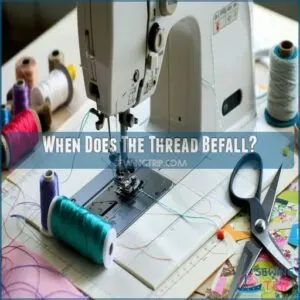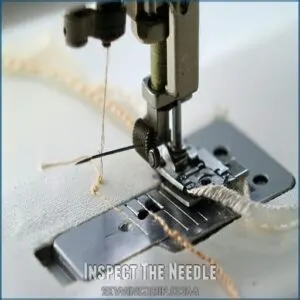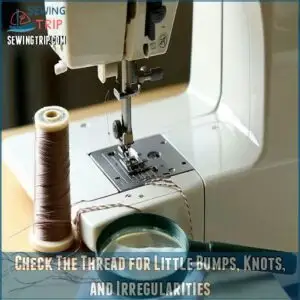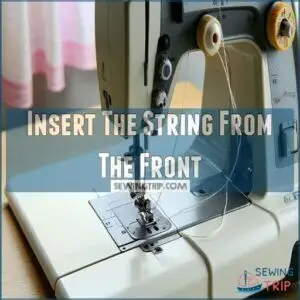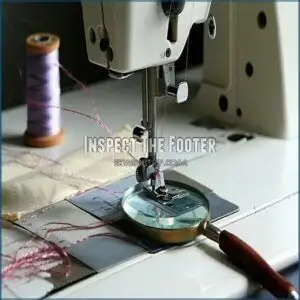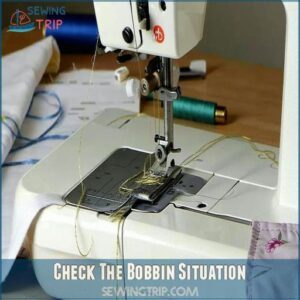This site is supported by our readers. We may earn a commission, at no cost to you, if you purchase through links.
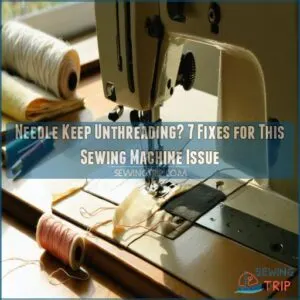
First, double-check your machine’s threading path—it should be smooth without any snags. Make sure your needle is inserted correctly (flat side facing the back) and isn’t bent or damaged.
Adjust the thread tension so it’s balanced, and leave a long thread tail before starting. Also, confirm your thread isn’t catching on tiny knots or the spool itself.
Still frustrated? Peek at your manual for machine-specific tips—it’s basically the sewing family’s rulebook! Fix these, and you’ll stitch stress-free again in no time with proper care.
Table Of Contents
Key Takeaways
- Rethread your machine carefully, keeping the presser foot up, and ensure the thread follows a smooth, tangle-free path through all guides.
- Inspect your needle for damage or misalignment; replace bent or dull needles immediately to avoid thread flow disruptions.
- Adjust thread tension to a balanced setting and leave at least a 6-inch thread tail to prevent unthreading as you start sewing.
- Check for knots, weak spots, or irregularities in your thread, and ensure the spool and bobbin are properly aligned and functioning smoothly.
Beginning by Examining The Thread Stress
Let’s start by checking your sewing machine’s thread tension—it’s often the prime suspect when your needle keeps unthreading.
Is your thread too tight, too loose, or is something else going on?
Did You String The Machine Appropriately?
Machine threading mistakes can escalate needle unthreading problems fast. Start fresh and rethread! Keep the presser foot up and make certain the thread smoothly follows every guide.
Missteps? Check these essentials: To resolve issues, consult thread guides for troubleshooting tips.
- Presser foot position (always up during threading).
- Tension discs engaged properly.
- Spool alignment secured.
- Thread path clear, no tangles.
- Refer to your manual for threading tips.
When Does The Thread Befall?
If your needle keeps unthreading, ask yourself: when exactly does the thread fall out?
Thread breakage during high sewing speeds often points to tension issues or mismatched fabric type.
Does it unthread as you start sewing? Check tension and thread length.
Mid-sew? Revisit your machine maintenance.
Pinpoint these moments—they’re clues to your needle unthreading problem.
Inspect The Needle
A bent or burred needle could be the culprit behind your needle unthreading problem. Needle damage disrupts thread flow, creating sewing issues like skipped stitches or knotting.
Check needle alignment by ensuring it’s straight and properly installed. Replace bent needles immediately. Regular needle maintenance prevents needle unthreading causes.
To resolve issues, understanding thread tension is essential for smooth sewing. Stick with high-quality needles; they’re worth it to avoid constant frustration!
Check The Thread for Little Bumps, Knots, and Irregularities
Thread quality can cause all kinds of needle unthreading headaches. Check for thread issues like bumps, fraying, or knot formation. Low-quality or old thread often has hidden fiber problems that lead to thread irregularities.
Proper thread tension adjustment is also vital to prevent thread breakage and guarantee smooth sewing.
- Avoid threads with visible knots or weak spots.
- Replace foam-spooled or poorly stored yarn.
- Make sure the thread unwinds smoothly without catching, to prevent needle unthreading headaches and ensure smooth sewing.
Insert The String From The Front
Let’s troubleshoot needle threading issues! Proper threading techniques are key to avoiding needle unthreading problems.
Verify the thread path is smooth—align the spool properly, pull the thread through string guides, and wrap it snugly around the take-up lever. Always thread the needle front-to-back to prevent front tension mishaps.
Using the right Sewing Machine can also make a difference in preventing unthreading. This simple needle threading tip eliminates unnecessary frustration!
Inspect The Footer
Sometimes the culprit hides in plain sight—your machine foot. A quick foot inspection solves surprises like footer damage or burrs that disrupt thread flow.
Check the presser foot for scratches or holes; replace it if needed. Make certain it’s up during threading.
Don’t forget spool pin and cap alignment; misplacement messes with tension and causes needle unthreading. Understanding the Sewing Machine foot is vital for maintaining proper thread flow and preventing unthreading issues.
Check The Bobbin Situation
If your needle keeps unthreading, the bobbin might be the culprit. Common bobbin problems can mess with thread tension and spool alignment. Understanding the Sewing Machine is vital for identifying these issues.
Try this:
- Inspect the bobbin case: Clean lint or debris and make certain correct bobbin installation.
- Check the bobbin thread: It should unwind smoothly from the top-right.
- Replace damaged parts: A faulty bobbin or bobbin case can cause chaos.
If None of These Functions
If you’ve gone through all the previous steps and the needle unthreading persists, it’s time to examine a few other factors.
First, verify you’re using the right thread material for your fabric and needle. Using low-quality or old thread can lead to issues, so ponder an upgrade.
Next, evaluate the tension of your top thread. If it’s too high or too low, adjust it according to your user manual. Sewing at a slower speed can also reduce strain on the needle and thread, so give that a try.
Additionally, check your machine oil levels and fabric thickness. These factors can impact the needle’s performance and thread tension. Considering computerized sewing machines with automatic functions can also help prevent such issues.
If issues remain, consult your manual or a technician for further sewing machine troubleshooting. Remember, each factor plays a role in the smooth operation of your machine and preventing needle unthreading.
Frequently Asked Questions (FAQs)
What should I do if my needle is unthreading?
An ounce of prevention is worth a pound of cure.
Double-check your threading process, ensuring the take-up lever is at its highest.
Secure 6-inch thread tails, inspect for needle damage, and adjust upper tension.
What are the guidelines for needle stick injury?
Don’t panic—wash the wound with soap and water immediately.
Apply pressure to stop bleeding and cover with a clean bandage.
Seek medical advice promptly for testing and preventative treatment like vaccines or post-exposure prophylaxis.
Why does my sewing machine needle keep coming unthreaded?
Imagine this scenario: you’re ready to sew, but the needle keeps betraying you.
It’s likely improper threading, tension imbalance, or a low take-up lever position.
Double-check threading steps, tension settings, and lever height.
What if I have difficulty threading a needle?
Threading a needle can feel like threading the eye of a storm, but try a needle threader
or snip the thread’s end cleanly.
Wetting the thread with spit? Classic trick—it still works wonders!
Why does my thread keep unthreading when I sew?
It’s like your thread’s got stage fright! Check thread tension, threading path, and spool placement.
Keep 6-inch thread tails, position the take-up lever high, and replace bent needles.
Shortcuts here lead to unthreading headaches.
Why does my thread jump out of the needle?
Your thread may jump out of the needle if it’s too short, the tension’s off, or the take-up lever isn’t at the top.
Hold 6-inch thread tails and double-check your machine’s threading path.
Why does my needle keep coming unthreaded?
Imagine threading your needle as walking a tightrope—small missteps lead to trouble.
Check that your needle’s threaded properly, tension’s balanced, and thread tails aren’t too short.
Also, raise the take-up lever before starting.
Why does my needle keep cutting thread?
A needle cutting thread usually happens if it’s dull, has burrs, or isn’t the right size for the thread.
Swap it out for a fresh one and make certain it matches your fabric and thread type.
How do you get thread to stay on a needle?
Keep thread on the needle by pulling 6-8 inches through after threading, holding it taut when starting.
Verify your threading follows the manual, the tension’s balanced, and the take-up lever’s fully raised.
Why does my sewing needle keep falling out?
Your needle keeps falling out because it’s likely not tightened enough in the clamp.
Double-check you’re inserting it all the way and firmly tightening the screw.
A loose screw? It’s basically inviting chaos!
Conclusion
Imagine this: Your sewing’s flowing like butter, no more interruptions.
When your needle keeps unthreading, it’s often tiny details like tension, threading, or a pesky damaged thread causing chaos.
By rechecking your setup—needle placement, smooth threading, balanced tension—you’re back on track in no time.
Don’t forget to scan for knots or bumps in the thread, and show your bobbin some love too.
With these quick tweaks, you’ll sew hassle-free and enjoy the process again!


